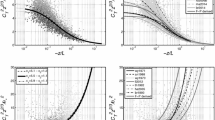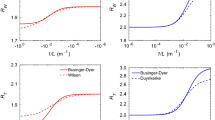Abstract
We present a method to detect influences of boundary-layer processes on surface-layer measurements, using statistics and spectra of surface-layer variables only. We validated our detection method with boundary-layer measurements. Furthermore, we confirm that Monin–Obukhov similarity functions fit well to temperature-variance data obtained at two different homogeneous surfaces. However, we found that humidity variance measurements deviate from the universal functions above one of the two studied surfaces for days on which entrained air reached the surface layer. These results confirm that Monin–Obukhov similarity theory should be used with care in the analysis of surface-layer data. Finally, we propose the use of an extra term in flux-variance relations that depends on the entrainment ratio for humidity and on the boundary-layer height. If boundary-layer measurements are not available, we show how the entrainment ratio for humidity can be approximated from the skewness of the humidity distribution.












Similar content being viewed by others
References
Angevine WM (2008) Transitional, entraining, cloudy, and coastal boundary layers. Acta Geophys 56(1):2–20
Betts AK (1992) FIFE atmospheric boundary layer budget methods. J Geophys Res 97(D17):18523
Braam M, Bosveld FC, Moene AF (2012) On Monin–Obukhov scaling in and above the atmospheric surface layer: the complexities of elevated scintillometer measurements. Boundary-Layer Meteorol 144(2): 157–177
Canut G, Lothon M, Saïd F, Lohou F (2010) Observation of entrainment at the interface between monsoon flow and the Saharan air layer. Q J R Meteorol Soc 136(S1):34–46
Couvreux F, Guichard F, Masson V, Redelsperger J-L (2007) Negative water vapour skewness and dry tongues in the convective boundary layer: observations and large-eddy simulation budget analysis. Boundary-Layer Meteorol 123(2):269–294
Cuxart J, Morales G, Terradellas E (2002) Pressure transport terms for the nocturnal stable boundary layer. Boundary-Layer Meteorol 105(1994):305–328
De Bruin H, Kohsiek W, van den Hurk J (1993) A verification of some methods to determine the fluxes of momentum, sensible heat, and water vapour using standard deviation and structure parameter of scalar meteorological quantities. Boundary-Layer Meteorol 63:231–257
De Bruin H, van den Hurk BJJM, Kroon LJM (1999) On the temperature-humidity correlation and similarity. Boundary-Layer Meteorol 93:453–468
de Moortel I, Munday S, Hood A (2004) Wavelet analysis: the effect of varying basic wavelet parameters. Solar Phys 222(2):203–228
Deardorff J (1980) Cloud top entrainment instability. J Atmos Sci 37:131–147
Farge M, Kevlahan N, Perrier V, Goirand E (1996) Wavelets and turbulence. Proc IEEE 84(4):639–669
Graf A, Schüttemeyer D, Geiß H, Knaps A, Möllmann-Coers M, Schween JH, Kollet S, Neininger B, Herbst M, Vereecken H (2010) Boundedness of turbulent temperature probability distributions, and their relation to the vertical profile in the convective boundary layer. Boundary-Layer Meteorol 134(3):459–486
Hägeli P, Steyn D, Strawbridge K (2000) Spatial and temporal variability of mixed-layer depth and entrainment zone thickness. Boundary-Layer Meteorol 97(1):47–71
Högström U (1996) Review of some basic characteristics of the atmospheric surface layer. Boundary-Layer Meteorol 78(3–4):215–246
Hsieh C, Katul G, Chi T-W (2000) An approximate analytical model for footprint estimation of scalar fluxes in thermally stratified atmospheric flows. Adv Water Resour 23:765–772
Hudgins L, Friehe CA, Mayer M (1993) Wavelet transforms and atmospheric turbulence. Phys Lett 71(20):3279–3283
Kaimal JC, Wyngaard JC, Izumi Y, Coté OR (1972) Spectral characteristics of surface-layer turbulence. Q J R Meteorol Soc 98(417):563–589
Katul GG, Sempreviva AM, Cava D (2008) The temperature humidity covariance in the marine surface layer: a one-dimensional analytical model. Boundary-Layer Meteorol 126:263–278
Kimmel SJ, Wyngaard JC, Otte MJ (2002) Log-chipper turbulence in the convective boundary layer. J Atmos Sci 59(6):1124–1134
Kormann R, Meixner FX (2001) An analytical footprint model for non-neutral stratification. Boundary-Layer Meteorol 99:207–224
Lenschow DH, Wulfmeyer V, Senff C (2000) Measuring second-through fourth-order moments in noisy data. J Atmos Oceanic Tech 17(10):1330–1347
Lohou F, Saïd F, Lothon M, Durand P, Serça D (2010) Impact of boundary-layer processes on near-surface turbulence within the West African monsoon. Boundary-Layer Meteorol 136(1):1–23
Lothon M, Couvreux F, Donier S, Guichard F, Lacarrère P, Lenschow DH, Noilhan J, Saïd F (2007) Impact of coherent eddies on airborne measurements of vertical turbulent fluxes. Boundary-Layer Meteorol 124:425–447
Lothon M, Couvreux F, Durand P, Hartogensis O, Legain D, Lohou F, Pardyjak ER, Pino D, Reuder J, VilàGuerau de Arellano J, Alexander D, Augustin P, Bargain E, Barrié J, Bazile E, Bezombes Y, BlayCarreras E, van de Boer A, Boichard JL, de Coster O, Cuxart J, Dabas A, Darbieu C, Deboudt K, Delbarre H, Derrien S, Faloona I, Flamant P, Fourmentin M, Garai A, Gibert F, Gioli B, Graf A, Groebner J, Guichard F, Jonassen M, van den Kroonenberg A, Lenschow D, Martin S, Martinez D, Mastrorillo L, Moene AF, Molinos F, Moulin E, Pietersen H, Piguet B, Pique E, RománGascón C, Saïd F, Sastre M, Seity Y, Steeneveld GJ, Toscano P, Traullé O, Tzanos YCD, Wacker S, Wildmann N, Zaldei A (2012) The boundary layer late afternoon and sunset turbulence 2011 field experiment. In: 20th symposium on boundary layers and turbulence/18th conference on air-sea interaction, Boston, Massachusetts, USA, 13 July 2012, 14B.1
Mahrt L (1991) Boundary-layer moisture regimes. Q J R Meteorol Soc 117(497):151–176
Mahrt L, Lenschow DH (1976) Growth dynamics of the convectively mixed layer. J Atmos Sci 33:41–51
Mauder M, Desjardins RL, Oncley SP, MacPherson I (2007) Atmospheric response to a partial solar eclipse over a cotton field in central California. J Appl Meteorol Climatol 46(11):1792–1803
Michels BI, Jochum AM (1995) Heat and moisture flux profiles in a region with inhomogeneous surface evaporation. J Hydrol 166(3–4):383–407
Moene AF, Schüttemeyer D (2008) The effect of surface heterogeneity on the temperature humidity correlation and the relative transport efficiency. Boundary-Layer Meteorol 129(1):99–113
Moene AF, Michels BI, Holtslag AAM (2006) Scaling variances of scalars in a convective boundary layer under different entrainment regimes. Boundary-Layer Meteorol 120(2):257–274
Moeng C-H, Wyngaard JC (1989) Evaluation of turbulent transport and dissipation closures in second-order modeling. Am Meteorol Soc 46(14):2311–2330
Monin AS, Obukhov AM (1954) Basic laws of turbulent mixing in the surface layer of the atmosphere. Trudy geofiz inst AN SSSR 24(151):163–187
Obukhov AM (1946) Turbulence in an atmosphere with a non-uniform temperature. Trudy Inst Theor Geofiz AN SSSR 1:95–115
Oncley SP, Friehe CA, Larue JC, Businger JA, Itsweire EC, Chang SS (1996) Surface-layer fluxes, profiles, and turbulence measurements over uniform terrain under near-neutral conditions. J Atmos Sci 53(7):1029–1044
Patton EG, Sullivan PP, Davis KJ (2003) The influence of a forest canopy on top-down and bottom-up diffusion in the planetary boundary layer. Q J R Meteorol Soc 129(590):1415–1434
Pino D, Vilà-Guerau de Arellano J, Duynkerke PG (2003) The contribution of shear to the evolution of a convective boundary layer. J Atmos Sci 60(16):1913–1926
Schotanus P, Nieuwstadt F, De Bruin H (1983) Temperature measurement with a sonic anemometer and its application to heat and moisture fluxes. Boundary-Layer Meteorol 26:81–93
Sempreviva AM, Gryning S-E (2000) Mixing height over water and its role on the correlation between temperature and humidity fluctuations in the unstable surface layer. Boundary-Layer Meteorol 97:273–291
Sempreviva AM, Højstrup J (1998) Transport of temperature and humidity variance and covariance in the marine surface layer. Boundary-Layer Meteorol 87:233–253
Sorbjan Z (1996) Effects caused by varying the strength of the capping inversion based on a large eddy simulation model of the shear-free convective boundary layer. J Atmos Sci 53(14):2015–2024
Tapper NJ (1990) Urban influences on boundary layer temperature and humidity: results from Christchurch, New Zealand. Atmos Environ 24B(1):19–27
Terradellas E, Morales G, Cuxart J, Yagüe C (2001) Wavelet methods: application to the study of the stable atmospheric boundary layer under non-stationary conditions. Dyn Atmos Oceans 34(2–4):225–244
van de Boer A, Moene AF, Schuettemeyer D (2013) Sensitivity and uncertainty of analytical footprint models according to a combined natural tracer and ensemble approach. Agric For Meteorol 169:1–11
van Dijk A, Moene AF, De Bruin HAR (2004) The principles of surface flux physics: theory, practice and description of the ECPACK library. Internal Report 2004/1, Meteorology and air quality group, Wageningen University, Wageningen, the Netherlands (March 2004), 99 pp
Vilà-Guerau de Arellano J (2004) Entrainment process of carbon dioxide in the atmospheric boundary layer. J Geophys Res 109(D18):1–15
Webb E, Pearman G, Leuning R (1980) Correction of flux measurements for density effects due to heat and water vapour transfer. Q J R Meteorol Soc 106:85–100
Wilczak JM, Oncley SP, Stage SA (2001) Sonic anemometer tilt correction algorithms. Boundary-Layer Meteorol 99:127–150
Acknowledgments
We greatly thank Oscar Hartogensis, Olivier de Coster, Henk Pietersen (Wageningen UR, the Netherlands) and Martin Lennefer (University Bonn, Germany) for their help with EC measurements before, during and after the BLLAST campaign. Furthermore, we thank Christine Moene for assisting in mapping the surroundings of the EC stations. We also thank Miranda Braam for her assistance with data processing and visualizing Fig. 1, and Jordi Vilà-Guerau de Arellano and Huug Ouwersloot (Wageningen UR, the Netherlands) for their critical notes on our study. We thank Fabienne Lohou (Laboratoire d’Aérologie Toulouse, France) and two anonymous reviewers for their critical comments and helpful suggestions. Furthermore, we thank Ned Patton (NCAR Boulder, US) for providing the detailed data from his LES study of 10 years ago. This work was financed by the DFG (Deutsche Forschungsgemeinschaft) project GR2687/3-1 and SCHU2350/2-1; links between local-scale measurements and catchment-scale measurements and modelling of gas exchange processes over land surfaces. The BLLAST field experiment was made possible thanks to the contribution of several institutions and supports: INSU-CNRS (Institut National des Sciences de l’Univers, Centre national de la Recherche Scientifique, LEFE-IDAO program), Météo-France, Observatoire Midi-Pyrénées (University of Toulouse), EUFAR (EUropean Facility for Airborne Research) and COST ES0802 (European Cooperation in the field of Scientific and Technical). The field experiment would not have occurred without the contribution of all participating European and American research groups, which all have contributed in a significant amount (see supports). The BLLAST field experiment was hosted by the instrumented site of Centre de Recherches Atmosphériques, Lannemezan, France (Observatoire Midi-Pyrénées, Laboratoire dAérologie). BLLAST data are managed by SEDOO, from Observatoire Midi-Pyrénées. The MODEM radiosoundings were supported by CNRS, University of Toulouse and the FEDER program (Contract nr. 34172—Development of the instrumentation of Observatoire Midi-Pyrénées—PIRENEA—ESPOIR). The 60-m tower equipment was also supported by CNRS, Université Paul Sabatier and by the European POCTEFA FluxPyr program.
Author information
Authors and Affiliations
Corresponding author
Appendix
Appendix
Vertical profiles of temperature (red) and humidity (blue) from all successful radiosoundings at a site 1 km from our EC stations are shown in Fig. 13. We manually added a first-order jump model to every vertical profile (black lines). Corresponding surface and entrainment fluxes are given in Table 1. Soundings launched at a site 4 km from our EC stations and contributing calculated fluxes are shown in Fig. 14 and in Table 2 respectively.
Vertical profiles of temperature (red) and humidity (blue) obtained at a distance of 1 km from our EC stations, using radiosoundings (MODEM). From left to right, then from top to bottom, the sets of \(\theta \) and \(q\) are placed in chronological order. Black lines indicate the first-order jump model. Corresponding DOY and time are given above every vertical profile
Vertical profiles of temperature (red) and humidity (blue) obtained at a distance of 4 km from our EC stations, using radiosoundings (Vaisala). From left to right, then from top to bottom, the sets of \(\theta \) and \(q\) are placed in chronological order. Black lines indicate the first-order jump model
Rights and permissions
About this article
Cite this article
van de Boer, A., Moene, A.F., Graf, A. et al. Detection of Entrainment Influences on Surface-Layer Measurements and Extension of Monin–Obukhov Similarity Theory. Boundary-Layer Meteorol 152, 19–44 (2014). https://doi.org/10.1007/s10546-014-9920-8
Received:
Accepted:
Published:
Issue Date:
DOI: https://doi.org/10.1007/s10546-014-9920-8






